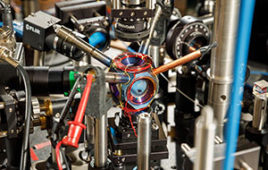
The illustration shows an optical antenna coupled to a cluster of scintillators at its end. The blue waves in the background represent the X-rays, the intense and bright green sphere corresponds to the scintillation cluster and the sparks within the antenna body symbolize the X-ray-excited photon emission from the scintillators being strongly directed toward a narrow single mode optical fiber. Image: Miguel Angel Suarez, FEMTO-ST Institute
Using a tiny device known as an optical antenna, researchers have created an X-ray sensor that is integrated onto the end of an optical fiber just a few tens of microns in diameter. By detecting X-rays at an extremely small spatial scale, the sensor could be combined with X-ray delivering technologies to enable high-precision medical imaging and therapeutic applications.
“We want to develop this technology so that it could be used in radiotherapy, for example,” says Thierry Grosjean, from FEMTO-ST Institute, CNRS, in France. “Specifically, the sensor could allow a real-time measurement of how much radiation is being delivered to a tumor via endoscopy.”
In The Optical Society (OSA) journal Optics Letters, the researchers demonstrate their new X-ray sensor using low energy X-rays. They say that the same principle should work with the high-energy X-rays used for medical applications such as imaging and radiotherapy.
Like many of today’s X-ray applications, the new X-ray sensor uses indirect detection. Rather than directly sensing X-rays, this method uses a special detector called a scintillator, which absorbs the X-rays and then emits light that is detected by an optical camera.
Achieving indirect X-ray detection on a small scale is challenging because scintillators emit photons in all directions. Scaling scintillators down to a very small size means that they will emit very few photons, making it almost impossible for the camera to catch enough photons at just the right angle. The researchers turned to optical antennas to help with this challenge.
Because optical antennas have been used to control the light emission from fluorescing molecules, the researchers thought they might also control light emitted by scintillators. “An optical antenna works much like a radio frequency antenna, offering a way to interconnect an emitter with free-space,” says Grosjean. “We demonstrated that they can be used to control the directionality of the emission from scintillators.”
To make the X-ray sensor, the researchers used an optical antenna to connect a single mode optical fiber with a tiny cluster of scintillators. They fabricated the optical antenna, just a few microns wide, onto the end of the fiber and grafted the scintillator cluster at its extremity. Light emitted from the scintillators hits the antenna and is directed into the fiber, where it travels to a remote optical detector. This setup keeps the electronics away from the X-rays, which protects electronics from damage after repeated use.
Although the X-ray sensor fabrication required a cleanroom facility, the researchers said it was not a difficult or expensive process. They are currently working on procedures that might make it even easier to graft the scintillators onto the fiber antenna.
From their experiments, the researchers estimated that the sensor has a spatial resolution on the order of 1 micron, which they are working to increase to about 100 nanometers. This improved resolution would allow the device to distinguish chemical components in composite materials by using the fiber tip to conduct low-energy X-ray scanning microscopy.
In addition to expanding the technology to work with the high-energy X-rays required for medical applications, the researchers are also investigating whether optical antennas could enable faster X-ray detectors. Since the devices have been shown to shorten the time between light absorption and light emission in fluorescence processes, the antennas might also shorten the time between X-ray absorption and light emission within scintillators — thus creating a faster way to detect X-rays.
Source: The Optical Society




